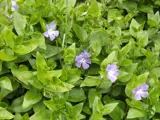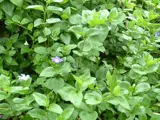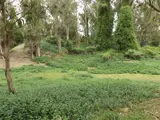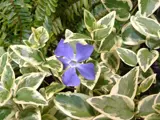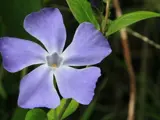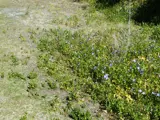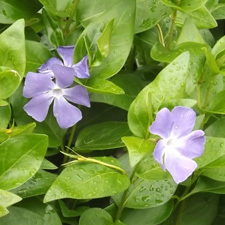 Periwinkle
Periwinkle
Common name: Periwinkle
Botanical name: Vinca major
Management category: Sustained control - Rule 5a applies
Named after its flower colour it is originally from the Mediterranean. It was introduced to New Zealand as an ornamental species and was recorded as naturalised in 1870.
Why is it a pest?
- Creeping, layering habit allows it to form dense, long-lived stands.
- Smothers ground in open or shady conditions, prevents seedlings of native species from establishing and open habitat for other weed species to establish.
Where is it found?
Margins of disturbed bush and shrubland, streamsides, coastlines, fernland and rocky and bare land.
What does it look like?
- Prostrate, scrambling perennial with short rhizomes and green, hairless, trailing stems that take root where they come into contact with soil.
- Glossy dark green or occasionally variegated (green and white) leaves.
- Solitary, blue-violet, five-petalled flowers appear from January to December.
What are the rules?
Sustained control
Sustained Control pests are well established in the region and preventing the spread is no longer a realistic objective. Management focuses on reducing general impacts of the pest. Landowners/occupiers are responsible for the control of these pest species on their land. Council may enforce control.
Under rule 5a of the RPMP landowners/occupiers must destroy this pest if required by a written direction from an authorised person unless a property specific pest management agreement has been agreed and signed between the occupier and the Council.
Criteria to meet Rule 5A include when the species is being actively managed by council, other agency and or community group, on an adjacent property. See the Regional Pest Management Plan 2020-2030 rules for Sustained control pests for more information.
How do you get rid of it?
- Dig-out (all year) – small sites, incinerate or dispose of material at transfer station.
- Spray (spring to autumn).
May need spraying for 2-3 years for total control
CAUTION: When using any herbicide or pesticide, PLEASE READ THE LABEL THOROUGHLY to ensure that all instructions and directions for the purchase, use and storage of the product, are followed and adhered to.
Read more on pest control advice, information and regulations.
Images

